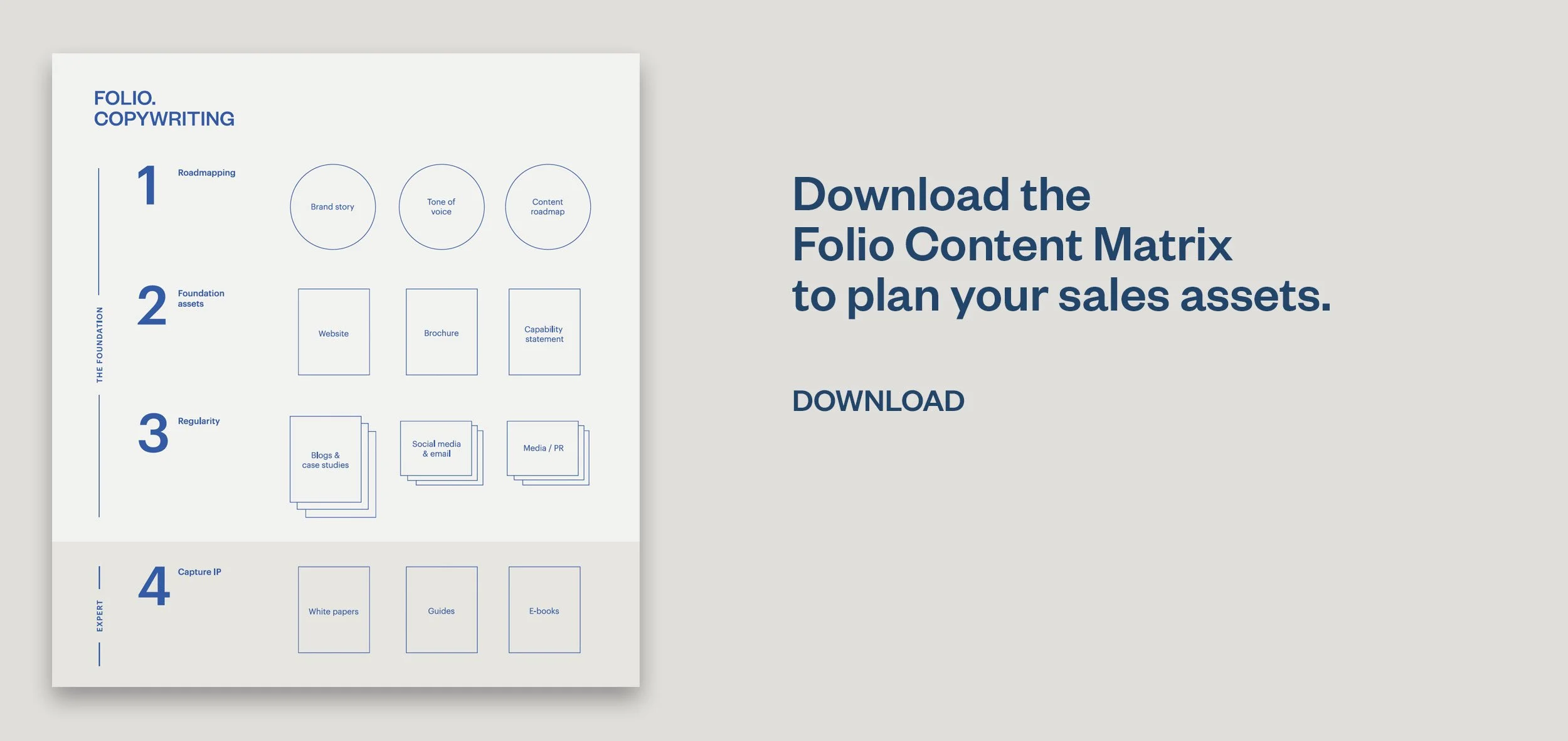Empathy in storytelling
Humans love to tell and listen to stories. From childhood, storytelling has been a natural way for us to connect and converse – a fundamental part of our daily lives, and business stories are no different.
When communicating in a business sales setting, we seek understanding, shared values and sense of purpose. Are they on a similar path? Do they understand my needs? Can they help me achieve my goals?
Essentially, we're looking for a culture of like-minded individuals who will be engaging and rewarding to work with. We're looking for collaborators who will help us reach our goals faster and with more value – both tangible and intangible.
Therefore, communicating your business in ways that inspire, inform and compel requires deep insight into what moves and motivates your ideal customer.
There are so many stories you can activate
Businesses are full of stories. Brand stories. People stories. Product stories. Service stories. Customer stories. Project stories. Innovation stories. Impact stories. Community stories. Origin stories. Sustainability stories. Collaboration stories. And more.
They can be told one-to-one or one-to-many. They can be told using still images, moving images, words, text, sound, animation, infographics or sketches. They can be broadcast on websites, social media, email, YouTube and third-party media. And they can be shared in presentations and conversations.
Stories are usually far more engaging when you 'show, don't tell'. Examples, demonstrations and analogies help people 'picture' the outcomes you create.
Architecture Week 2023.
Te Kāhui Whaihanga NZIA Auckland Branch newsletter.
The cover image of Rewi Thompson is by Jane Ussher.
Resumes don't win work; compelling stories do
Brand storytelling is the art of crafting narratives that draw people in. With so much information being generated by AI, you need to differentiate your communications with a human voice. As Margaret Atwood notes, 'You’re never going to kill storytelling, because it’s built in the human plan. We come with it.'
Personable messaging connects one-to-one – your business is the author, and your ideal client is the reader. When you show your reader how you help them solve their biggest challenges and achieve their biggest goals, you show empathy and understanding.
Talking to people's pain points, needs and dreams brings a greater human dimension to your communications, fostering connection and trust. By harnessing the influence of storytelling, you'll nurture loyalty and shared purpose.
Example: Empathy in information management
One of our long-time clients is a business called Efficient. They have developed a new standard in information management and are designing a platform to automate document storage and retrieval. We wrote their brand story based on the value proposition ‘Information organised’. Here’s an excerpt:
Efficient is a new way of organising and managing documents and IP that enables anyone, anywhere to access the latest version of anything. Whether ‘anything’ is a document, a proposal, a project or a picture. Whether it was updated last year or five minutes ago.
No matter where it is now or where it’s likely to be going in the future, our automated index gets information off personal desktops and out of employees’ heads to enable easy document retrieval and sharing.
Every. Single. Thing.
Efficient ensures valuable knowledge is retained, updated, added to and securely filed.
The software catalogues, indexes and keeps track of everything that is important to your business. No matter how big your business is, or wants to be. Templates. Artwork. Manuals. Procedures. If it’s a thing, and it’s your thing, and an important thing, Efficient will make it easy to find and impossible to lose.
Efficient came about when a very organised person found herself stuck in a virtual filing room virtually knee-deep in virtual paper, trying to sort the whole mess out. She had an organisational epiphany, and the idea for Efficient was born – one index, one system, one source of truth.
This copy talks about the ‘what’ (organising and managing documents and IP), the ‘why’ (retaining valuable knowledge and easy document retrieval) and the ‘how’ (software that catalogues and indexes documents). Efficient demonstrates genuine empathy and understanding by speaking to the client’s pain, needs and dreams. The tone and rhythm make a seemingly dry topic engaging and personable. What is effectively a sales pitch feels conversational and helpful, building trust in the skill and expertise of the company.
Define. Communicate. Engage.
Adobe’s latest report on brand storytelling defines three steps. Step one: Define your story. ‘What does our business do, and how? Who does it serve? And what value do you provide?’ Use these questions to audit your business and develop your message architecture.
Step two: Communicate your story. Get your story out into the world with the right placement and promotion. In 2023 and now 2024, social media advertising is gaining more popularity and reliability for B2B industries.
Step three: Engage through storytelling. Coming full circle, we are reminded that ‘simply putting your brand story into the universe is the first step.’ How can we ensure the longevity of this process? Create and engage with your community, and foster connections and partnerships within your market.
The shortest stories are in the form of taglines and value propositions. Nike’s tagline and campaign ‘Just Do It' transcended a marketing message and became a mantra in athletics.
As energy, drive and engagement – for internal and external audiences – thoughtful words and ideas can have huge power and influence. Put your ideas and words to work to inspire, inform and compel – to activate your mission within the industries you serve.




